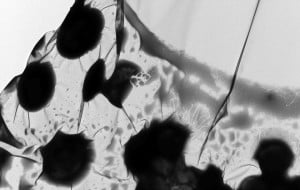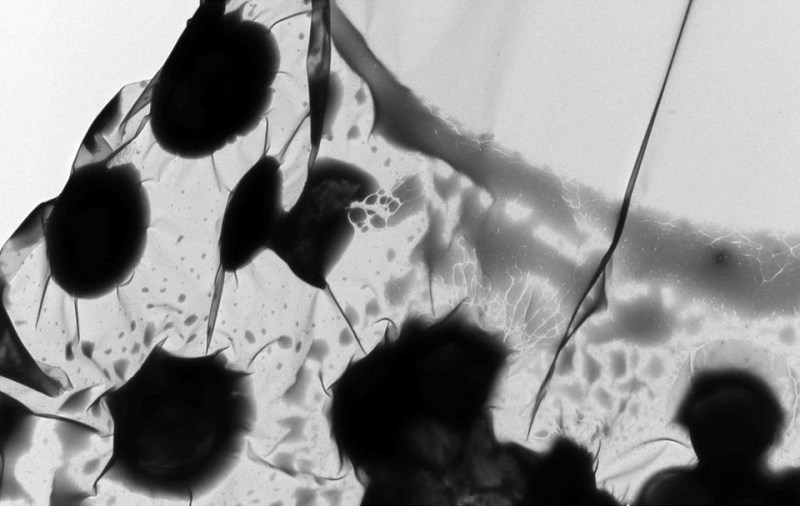
Casual visitors to the David W. Packard Electrical Engineering Building last Friday afternoon— had there been any, on the first day of a long weekend—might have wondered about the art exhibition displayed on a forest of small easels. This was no regular art exhibition, but “Art of Science,” (AoS) a popular show, now in its third year, organized by the Stanford Materials Research Society. AoS challenges Stanford faculty, staff and students to “show their work”— or, rather artwork, with a scientific angle, in no uncertain terms: “Science is boring. Art is stupid. PROVE US WRONG!”
This year’s 45 works were drawn from the disciplines of Materials Science, Psychiatry, Physics, Bioengineering, Mechanical Engineering, Chemistry, Electrical Engineering, Medicine, Radiology, Earth Systems, Computer Science and Geological and Environmental Science, as well as the fields of English, Dance and Art /Art History.
The exhibition organizer, materials science doctoral student Ashwin Atre, said in a recent interview, “I think that all of these people who are submitting really enjoy the aesthetic side of what they do scientifically, and so it’s a nice way of celebrate that together.” Atre brought the idea from his undergrad alma mater, Princeton, which started a competition in 2005, and the Materials Research Society receives a small amount of funding from various organizations. In previous years, AoS was confined to science and engineering departments. This year, hoping to develop and further establish the event, Atre opened it up to the entire university: “I emailed every dean that I could find an email for,” he says.
Awards this year went to depictions of a section of mouse hippocampus by psychiatry professor Ahmad Salehi; a bit of overloaded Transmission Electron Microscopy grid by graduate students Michelle Davidson and Mathias Voges; and a Foldscope, or simple microscope, photo of a peacock wing by Marina Dimitrov ’17. People’s Choice awards, tallied on an iPad, went to a color interference microscope photograph of a film of a teardrop settling onto a contact lens by graduate student Saad Bhamla; and an altered 19th-century anatomical engraving by medical student Michael Nedelman.
Honorable Mentions went to an ultrasonic video of the heat-wave turbulence, otherwise invisible, generated by a wooden-match flame, by graduate students Victor Miller and Matt Tilghman; and the wavelike interference pattern displayed by phthalocyanine molecules sent through a nanofabricated grating, captured by fluorescence microscope, by postdoctoral researcher Thomas Juffman. This writer was fascinated as well by the PCBM (“a solubilized fullerene derivative”) crystals on a solar cell by graduate student Jonathan Bartelt; and the Soap Film Tunnel vortices under orange-yellow sodium-vapor light by postdoctoral researcher H. Dogus Akaydin.
If the high-tech sources of these striking abstract images strike some of us as comically esoteric, some of the artist-scientists admittedly have fun, too, employing slang and other unprofessional colloquialisms in their titles. “Chlorella in Living Color,” “Spiral Out— Keep Going!” “Bureau of Longitudes,” “Oriental Landscape Painting: Nano-Valley,” “Waitless Potential,” “Down the Drain,” “The A-Team,” “Of Cows and Men” and “The Ride of the Vaucheria” are a few examples of through-the-looking-glass absurdist wit. Two pieces are clearly humorous or satirical in intent: Cristina Zavaleta’s “The Father of Radiology and His Legacy” and Shawn Lin’s and Isabella Lai’s “A Modern Medical Education.”
While the great majority of the art on display took the form of photography (all 16” x 20”), traditional paintings and mixed-media works were shown as well, along with a half-dozen or so computer/video works. Creative nerds interested in participating in AoS 2015 will soon find images of all the 2014 artworks at http://www.stanford.edu/group/mrs/cgi-bin/wordpress/art-of-science.
Contact Dewitt Cheng at dewittc “at” stanford.edu.
